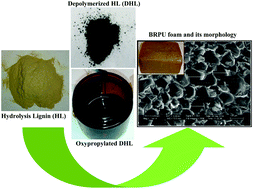Hydrolytic liquefaction of hydrolysis lignin for the preparation of bio-based rigid polyurethane foam
Abstract
Hydrolysis lignin (HL) was liquefied to a low average molecular weight (Mw) intermediate by employing a 50/50 (v/v) water–ethanol mixture. The effects of process parameters including the reaction temperature, the reaction time and the HL concentration were investigated and the liquefied hydrolysis lignin (LHL) products obtained were characterized by GPC, FTIR and 1H NMR. The best operating conditions appeared to be at 250 °C, 1 h with 20% (w/v) HL concentration, leading to ∼70 wt% yield of LHL (Mw ∼ 1000 g mol−1 and OHTotal ∼ 442 mg KOH g−1). The solid form LHL was derivatized into liquid polyols via oxypropylation with 50–70 wt% bio-content, which was subsequently utilized for the preparation of bio-based rigid polyurethane (BRPU) foams. All the foams were characterized in terms of their physical, mechanical and thermal properties & morphology. BRPU foams exhibit superior compression modulus and strengths to a reference foam prepared from commercial sucrose polyols provided by Huntsman Co. At a fixed formulation, i.e., a fixed percentage of physical blowing agent, BRPU foams showed the following sequence in terms of their compression modulus: sucrose polyol reference foam (2695.0 kPa) < LHL50PO50 (9202.0 kPa) < LHL60PO40 (19 847.0 kPa) < LHL70PO30 (21 288.0 kPa). All BRPU foams were thermally stable up to approximately 200 °C and thermal conductivity was low (0.030 ± 0.001 W m−1 K−1), making them suitable candidates for insulation material.

- This article is part of the themed collection: Lignin chemistry and valorisation

 Please wait while we load your content...
Please wait while we load your content...